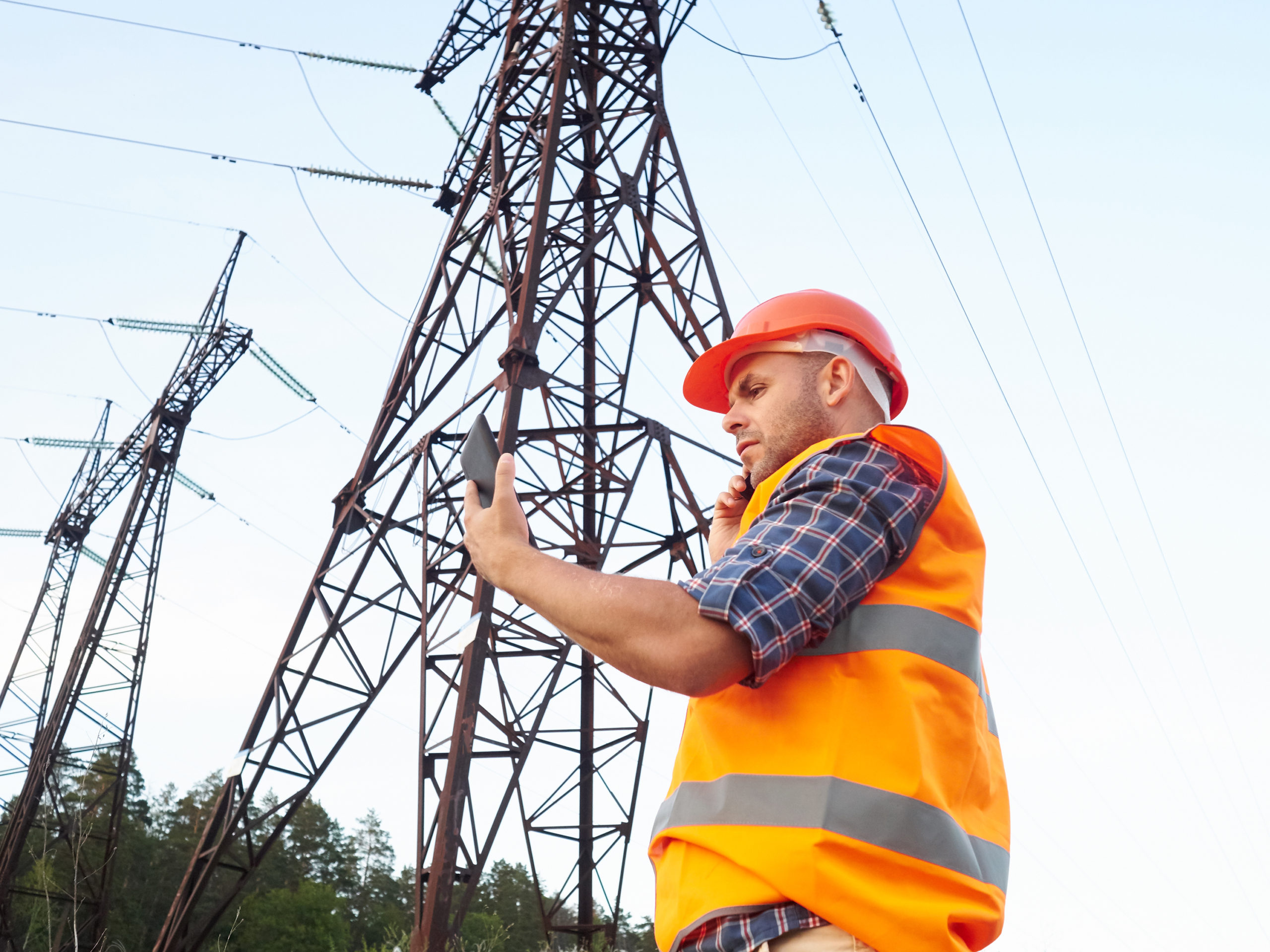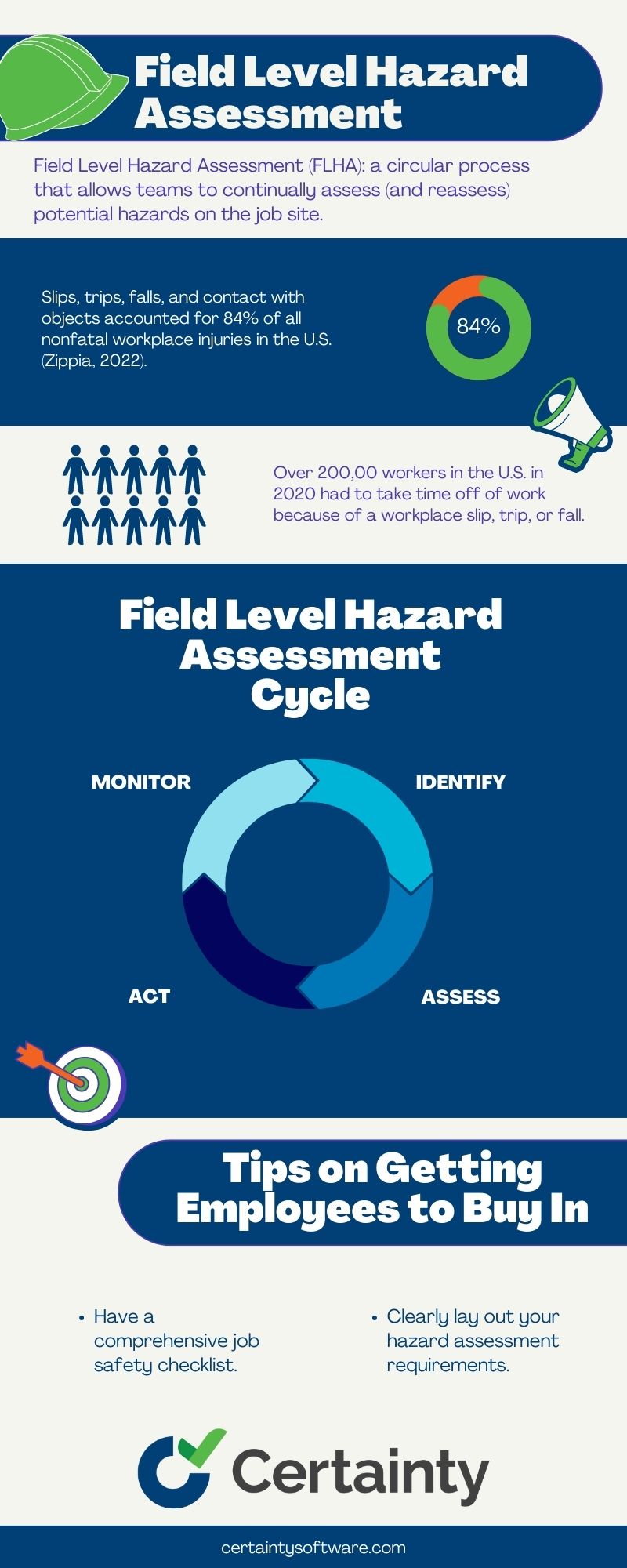
Hazards put both teams and projects at risk. If your staff is injured by on-site hazards, days off for recovery coupled with workers’ compensation processes can negatively impact project timelines and employee morale. According to recent data from the National Safety Council (NSC), more than 400,000 workers were injured from substance hazards in 2020. Additionally, over 200,000 workers had to take time off work after a fall, slip, or trip. A field level hazard assessment (FLHA) — also called a field level risk assessment (FLRA) — can help teams identify, assess, and resolve potential issues before they lead to injury.
But what exactly is a field level hazard assessment? How do teams carry out these assessments, and how do businesses ensure employee buy-in? Here’s what you need to know.
What is a Field Level Hazard Assessment?
A field level hazard assessment (FLHA) is used to collect relevant information relating to the condition of a job site that will help prevent or eliminate risks. Such risks include harm or damage to people, property, the work environment, or materials. As the name clarifies, it’s conducted out in the field by employees actively working on the project. The central tenant of a field hazard assessment is “stop and think”. By coming together before work starts, teams can collectively pinpoint potential issues and design a plan to address them.
Once hazards are identified, teams can either create plans to address them in the field or wait on specific remedies before beginning work. For example, if a large hole on the job site poses a safety risk, teams could use materials on-site to create highly visible barricades that significantly lower the risk of injury. If the field level hazard assessment uncovers issues that render work unsafe — such as flat tires on vehicles, electrical hazards in buildings, or extreme temperatures in confined spaces — specific tasks may need to wait until these issues are addressed.
Why Are Filed Level Hazard Assessments Important?
Every day while you operate in the field, you encounter a variety of risks. Some are self-evident, such as large machinery or sharp instruments, and some are concealed, such as poisonous materials or electrical cables. For this reason, before beginning any activity, you should perform a field-level hazard assessment as it will help in identifying and resolving risks to you and your colleagues. Not only that, it also increases your awareness of your surroundings and safe working practices.
Completing a field-level danger assessment is beneficial for your reputation, productivity, and health because it demonstrates your concern for your job and adherence to the guidelines. In the event that something goes wrong, it might also spare you from expenses and legal issues.
What are the Four Categories of Hazard Assessment?
When you work in the field, you want to be safe and healthy, right? You don’t want to get hurt by something that you didn’t see or expect. This is why, before to beginning any work, you must do a hazard assessment. It assists you in identifying and resolving any risks to the environment, your coworkers, or yourself. There are four primary categories of hazards that require your attention: physical, chemical, biological, and psychosocial. Let’s take a deeper look into each category.
Physical hazards: These include things like electric shocks, flames, harsh temperatures, hazardous radiation, loud sounds, and powerful vibrations that can injure your health or the environment. These risks may be measured and managed with the use of tools, machinery, or regulations that shield you from them.
Chemical hazards: Gases, vapors, liquids, solids, and dust that are toxic, combustible, explosive, or reactive are examples of chemicals that can harm human health or the environment. By utilizing fans, donning safety clothing, or adhering to proper handling and storage practices, you can quantify and manage these risks.
Biological hazards: These include organisms that can harm the environment or your body, such as fungi, bacteria, viruses, parasites, insects, plants, or animals that can lead to allergies, illnesses, or infections. By being clean, being vaccinated, or avoiding them, you can measure and limit these threats.
Psychosocial hazards: These include things like stress, aggression, harassment, discrimination, or a heavy job that might harm your mental or emotional health. By conversing with people, learning new things, or asking for assistance, you can quantify and manage these risks.
What is the Field Level Hazard Assessment Process?
The field level hazard assessment isn’t a straight line from point A to point B. Rather, it’s a circular process that allows teams to continually assess (and reassess) potential hazards on the job site. In-depth assessments are often carried out at specific milestones during a project. On the other hand, smaller-scale assessments may be completed every day before work starts.
The field level hazard assessment cycle contains four components:
Identify
Staff examines the worksite to identify potential hazards. These could include slip, trip, and fall hazards along with equipment issues or personal protective equipment (PPE) concerns.
Assess
Next is assessment, which is the consideration of the risk that each hazard presents. What potential outcomes could result from a hazard, and how would these outcomes impact the job?
Act
Once the staff has identified and assessed hazards, they can take corrective action to address these concerns. These hazard control actions should be documented as part of the field hazard assessment to ensure there’s a record of what’s been done, when, and its impact on total risk.
Monitor
Finally, teams must monitor the efficacy of their action plans: Did the control measures taken significantly reduce the risk? For how long? Continual monitoring helps improve hazard response and allows teams to make changes as needed to ensure site safety.
Once the cycle is complete, it begins again with the next hazard assessment, allowing companies to create a culture of ongoing improvement and hazard reduction.

30+ Audit and inspection checklists free for download.
How to Gain Field Level Hazard Assessment Buy-In
It’s not enough to simply create a hazard assessment plan — organizations also need employee buy-in to ensure these assessments are effective. Here’s why: If your field level hazard assessment evaluation, documentation, and reporting processes aren’t straightforward, teams may focus more on paperwork than pinpointing potential hazards.
Building a good assessment plan starts with a comprehensive job site safety checklist that helps employees quickly identify high-risk hazards and develop specific remedies in real time. Next, companies must lay out clear hazard assessment requirements — how often should these assessments be carried out? What needs to be included? How is hazard documentation captured and shared within the overall safety program? By developing an end-to-end process that facilitates employee hazard identification and provides them with the resources they need to address these issues, companies can help drive staff buy-in and boost the adoption of continual worksite safety culture.

You may also be interested in:
Near Miss Reporting: What it is and Why it’s Important
Keep it Seen, Keep it Safe: The Importance of Construction Safety Observations



